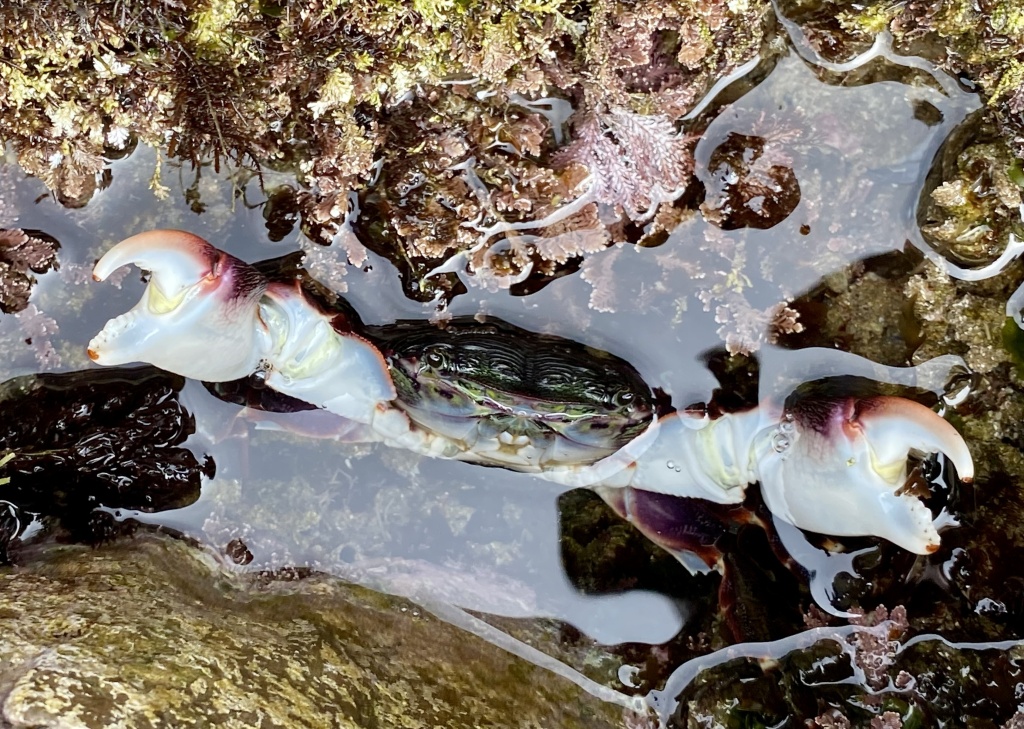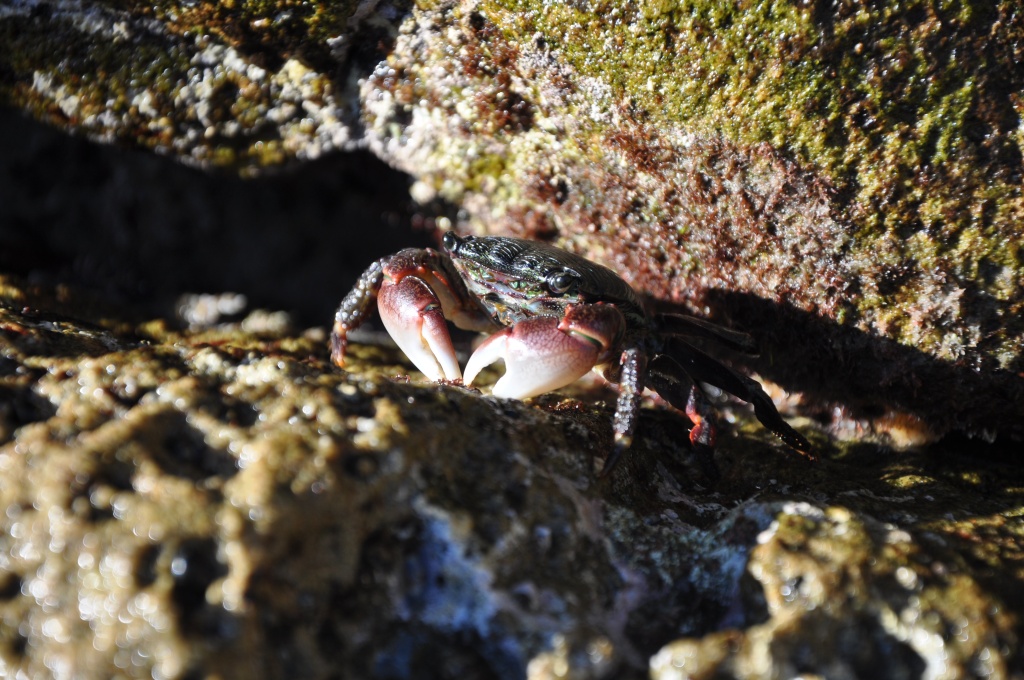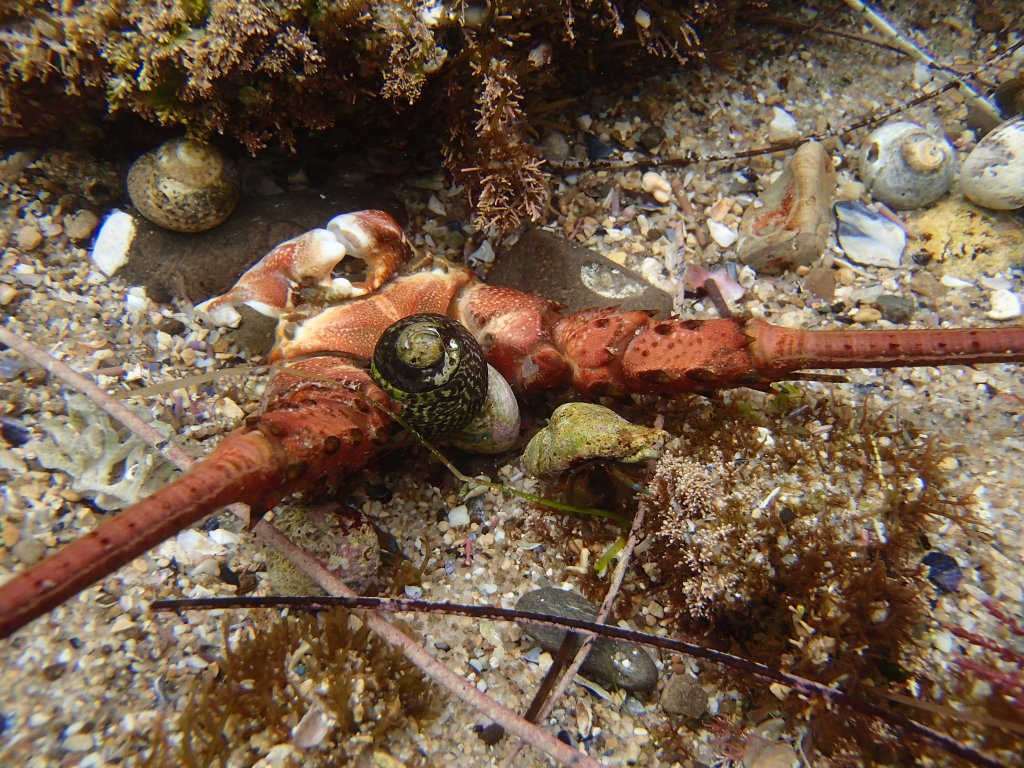5 Common Crustaceans to Look for at the Tide Pools

Crustaceans are staples at the tide pools because they are so abundant. Crabs are some of the first animals that many people see when visiting rocky shorelines.
There are a number of reasons that the tide pools are overflowing with crabs and other crustaceans. The first is that the rocks that make up tide pools provide excellent shelter and abundant food for crustaceans that sand doesn’t. Crustaceans are also well suited to the half-ocean, half-land lifestyle of the tide pools because they can survive long periods of time in the air, only by keeping their gills moist. If their gills are wet, they can absorb oxygen and scuttle around on the land as long as they want.
For all these reasons, tide poolers can expect to see a number of crustaceans when tide pooling, but what kinds should you look for? The types of crustaceans you will see will vary by location, but here is a list of common crustaceans that you might see at your local tide pools.
1. Hermit Crabs
Superfamily Paguroidea

You guessed it! Some of the most common crustaceans seen in the tide pools are hermit crabs. These crabs literally blanket the bottom of some tide pools and are often see in huge numbers. (There are two in the picture above!)
Hermit crabs are known for living in shells unlike most other crabs that rely only on their hard exoskeleton for protection. A hermit crab without a shell is very vulnerable as it is small and not very fast. Easy pickings for a hungry shore bird. Hermit crabs don’t make their own shells like snails do, but often steal discarded snail shells. When the crab has grown too big for its shell, it has to take it off and find a new one that fits better. This can be dangerous because the crab has to leave its shell temporarily while it gets into its new one.
This vulnerable state has led to an interesting behavior seen among hermit crabs. When one crab needs a new shell, but can’t find one that fits, it waits by a shell that is too large for itself. Eventually other crabs that also need bigger shells come and wait as well. The crabs line up in order of largest to smallest with the large empty shell at the front of the line. Then, starting with the largest crab, each individual moves into the new shell that was made vacant by the crab ahead of it in line. By cooperating in this way, the crabs spend very little time out of their shells.
Hermit crabs are truly fascinating creatures, despite being so commonplace. They are great for introducing a child to holding crabs, as they don’t pinch and are so abundant . In the Southern California tide pools, our staple hermit crab is the blueband hermit crab, named for its blue stripes on its legs.
2. Shore Crabs
Family Grapsidae

Another very common type of crab that you should look for at the tide pools are shore crabs. When I was a kid, we called these fiddler crabs because the male holds its large claw (think Davy Jones here) somewhat like a violin.
If you see a crab out of the water at the tide pools, chances are it’s a shore crab as these guys are very comfortable in the air. They are scavengers mostly, picking up the bits and pieces of food left behind by other animals. Effectually the garbage crew of rocky shores, these crabs keep the tide pools free from waste that would otherwise make the pools inhospitable.
The species of shore crab that I have encountered the most is the striped shore crab. From as small as a marble to as big as a smart phone, these crabs swarm the southern California tide pools. Some have even tried to eat skin off my hand when I held my camera still to film another creature.
Much like hermit crabs, shore crabs are so common that avid tide poolers often ignore them. But when more closely examined, these animals are very beautiful and boast various colors and patterns. Scuttling to and fro out of the way of your feet, these crustaceans are staple tide pool residents.
3. Kelp crabs
Family Epialtidae

If you are going to the tide pools looking for crustaceans, you should definitely keep an eye out for kelp crabs. There are several species of kelp crabs and what you will see will depend on where you are. Check out your area on iNat to see what other people have seen.
The image above was taken late at night, a few seconds before I slipped into the pool the crab was in. Not all tide pooling is glamorous. You can see better images of kelp crabs here.
Kelp crabs range in color from yellow-green to red to brown, the colors being greatly effected by the food the crab eats. They are larger than shore crabs, sometimes reaching 8 to 10 inches long and are recognizable by the point the main body makes between the crab’s eyes.
As their name suggests, kelp crabs live on kelp. This makes them lower intertidal and sub-tidal animals as kelp cannot live out of the water. Many species of kelp carbs are masters at camouflage, perfectly mimicking the color and size of a leaf of kelp.
Seeing a kelp crab is much less likely than see one of the other crustaceans we’ve discussed. They tend to be nocturnal and come out at night to feed on algae and kelp, making them for difficult for tide pools who don’t enjoy nighttime adventures to see.
4. Shrimp
Suborder Natantia

Perhaps most familiar to some from the menus of sea food restaurants, various species of shrimp occupy the tide pools, but they aren’t the same ones you eat. Shrimp are crustaceans because they have a hard exoskeleton and jointed leges, but unlike crabs, their bodies are long instead of rounded and many species swim more than they crawl.
There are multiple species of shrimp that inhabit the tide pools, but most people will never see them, especially if you aren’t looking for them. Perhaps the most common in the Southern California tide pools is the red rock shrimp. These animals are almost never seen during the day, but once the sun goes down, they come out sometimes in the hundreds, often hanging upside down on the underside of rocks (like in the photo above).
Other types of shrimp seen at the tide pools are the tiny ghost shrimp and the red banded transparent shrimp. These animals are all aquatic and can’t survive out of the water for very long, so you won’t see a shrimp crawling around on the rocks like you would a shore crab. Keep an eye out for these crustaceans, especially if you are tide pooling after dark.
5. Lobsters
Superfamily Nephropoidea

Again, probably more familiar from seafood restaurants, lobsters can occasionally be seen along the rocky shores of California. These large crustaceans look like huge shrimp with giant claws. They are great swimmers and can also crawl along the bottom of the ocean for long distances. They have been known to swim backward quickly to ram into divers, presumably as a self defense mechanism.
Lobsters prefer deeper waters than the tide pools offer, so seeing this crustacean alive along the shore is rare. But you are likely to see lobster casts and tails of dead animals or animals that have molted (like the image above), which is the process of shedding their outer skin when it has become too small, similar to snakes shedding their skin.
If you do see a lobster alive in the tide pools, consider it your lucky day, but don’t try to disturb or catch it as those pinchers are big and powerful. You are likely to only be able to see its legs, striped with orange or yellow on the California spiny lobster, sticking out from underneath a rock. Lobsters are nocturnal like many of the other less common crustaceans, so you are more likely to see one at night.
Bonus Crustacean: Barnacles
Infraclass Cirripedia

This one will probably surprise some people. Barnacles are possibly the most commonly seen crustaceans at the tide pools, but we don’t typically think of these animals as crustaceans. Often growing near mussels, these sessile animals (meaning they don’t move) look more like clams or mollusks than the crabs and shrimp we’ve seen.
But barnacles are, in fact, crustaceans with jointed legs, exoskeletons and everything. They are attached to the rock by their antennae, so you can think of them as having their foreheads stuck to the rock. There are around a thousand species of barnacles currently known to science, some of which live on whales and sea turtles. About 200 of those species live in the intertidal zone.
In Southern California, one of the most common kinds of barnacles are goose-neck barnacles. Much like many sessile mollusks, barnacles are filter feeders. When they are underwater, appendages that look like legs come out of their shells and draw in plankton from the water. But when they are exposed to air, they shut their shells tightly to conserve moisture.
What is a Crustacean?
For those interested in taxonomy (the classification of animals), crustaceans belong to the subphylum Crustacea. Most are free living aquatic animals, but some live on land and others are sessile (like barnacles). They generally have jointed legs and a hard exoskeleton, but lack bones. For more information, you can visit iNaturalist’s entry on crustaceans and see observations in your area.

Categories
tags
Subscribe to the blog
Sign up to receive weekly emails with tide pooling information and guides so you never miss a post!

Leave a comment